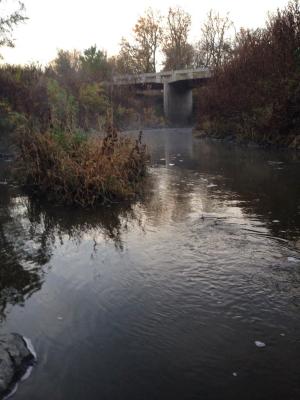Water Quality in the US Great Plains
Water Quality in the US Great Plains
Project Name: Effects of annual precipitation and runoff on water quality in the US Great Plains
Rationale

Declining surface water quality is of great concern across the US Great Plains. Recent trends in the earth climate can create abrupt changes in precipitation, which can alter the impact of runoff and leaching from soils on water quality. The overall goal of this research is to evaluate how changes in annual precipitation affect the natural water resources in the Great Plains. The Roca watershed in the Platte River Basin is selected for this study. The drainage area encompasses 106,880 acres of agricultural land in the southern region of Lancaster County in Nebraska. Numerous small streams receive overland flow from the watershed drainage area, eventually, these streams merge into Salt Creek. The Salt Creek runs through the town of Roca just before exiting the watershed. The US Geological survey (USGS) maintains a stream flow gauging station, which monitors stream flow and water quality coming from the watershed.
Approach
The authors developed a technique to estimate carbon, phosphorus, nitrogen and other nutrients losses from soils by runoff and loading into surface water body. The technique applies models to estimate losses of runoff and leaching water from watershed soils by rainfall. The technique assumes that dissolved chemicals are lost from surface soil that interacts with runoff and leaching water. The chemicals may include carbon, essential plant nutrients and toxic elements. Geographical information systems (GIS) are used to present data in watershed maps. The technique is quick and cost effective because it utilizes existing climatic (National Water and Climate Center), hydrologic (United States Geological Survey), land use (National Agricultural Statistics Service), and soils information (Soil Survey Geographic Database).
Soil samples are collected from major soils under different land uses in the Roca watershed. Soils are analyzed for important properties and dissolved carbon, macro-, and micro-nutrients and other elements content. During the rainy season, weekly stream water, and sediment samples are collected from Salt Creek at USGS station in Roca, Nebraska. The water and sediment samples are analyzed for pH, EC, carbon, nutrients, and other elements. The daily stream flow records in the National Water Information System (USGS) are used to calculate the weekly runoff volume. The runoff water volume and concentration of elements are used to quantify annual element losses from watershed soils during the rainy season (March Through October).
Outputs and Products
Research results and findings have applicability in environmental impact and assessment of natural water resources. Also, it has applicability in nutrient best management practices, sustainable agriculture and precision farming. The information should help us in adopting management practices that minimize the impact of abrupt changes in precipitation on water quality and improve soil health. The results have a direct application to the research mission of the NRCS agency, and link to the agency’s mission regarding the conservation and efficient utilization of natural resources.
Project Members
Moustafa Elrashidi, Cathy Seybold, Micheal Kucera, Steve Peaslee
Publications
Elrashidi, M.A., L.T. West, N. Persaud. 2012. Phosphorus loss and forms in runoff from watersheds in the Great Plains. Soil Sci. 177:638-649.
Elrashidi, M.A., and C.A. Seybold. 2013. Annual precipitation and effects of runoff-nutrient from agricultural watersheds on water quality. Soil Sci. 178:679-688.
Elrashidi, M.A., C.A. Seybold, and S.D. Peaslee. 2014. Application of soil survey to assess non-point source of contamination to surface water in agricultural watersheds: Heavy metals and alkaline earth elements. United States Department of agriculture, Natural Resources Conservation Service, National Soil Survey Center, Soil Survey Investigations Report No. 54.
Elrashidi, M.A and C.A. Seybold. 2014. Effects of precipitation on non-point source of alkaline earth elements contamination to surface waters in the US Great Plains. Soil Sci. 179:314-323.
Elrashidi, M.A. 2015. Effects of precipitation on non-point source of nitrogen contamination to surface waters in the US-Great Plains. Communications in Soil Science and Plant Analysis, 46:16-32.
Elrashidi, M.A, C.A. Seybold, and D.A. Wysocki. 2015. Effects of annual precipitation on heavy metals in runoff from soils in the US Great Plains. Water, Air & Soil Pollution. (2015) 226:417.

